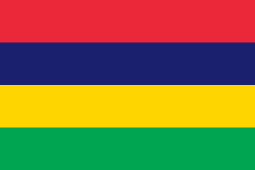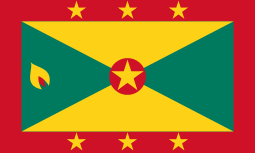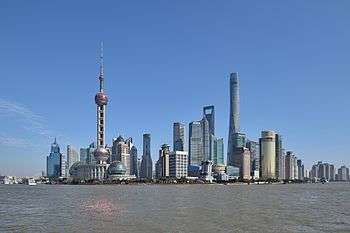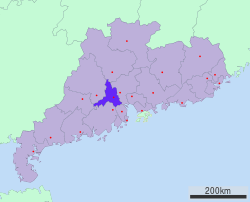Foshan
Foshan, formerly romanized as Fatshan, is a prefecture-level city in central Guangdong Province in southeastern China. The entire prefecture covers 3,848.49 km2 (1,485.91 sq mi) and has an urban population around 7.2 million. It forms part of the western side of the Pearl River Delta Economic Zone, which includes Guangzhou to the north and Shenzhen to the east.
Foshan is regarded as the home of the Cantonese forms of Chinese opera, kung fu, lion dancing, and dragon boat racing.
Name

Fóshān is the pinyin romanization of the city's Chinese name 佛山, based on its Mandarin pronunciation. The Postal Map spelling "Fatshan" derives from the same name's local Cantonese pronunciation. Other romanizations include Fat-shan[2] and Fat-shun.[3] Foshan means "Buddha Mountain" and, despite the more famous present-day statue of Guanyin or Kwanyin on Mount Xiqiao, who isn't a Buddha, it refers to a smaller hill near the centre of town where three bronze sculptures of Buddha were discovered in AD 628. The town grew up around a monastery founded nearby that was destroyed in 1391.[4]
The town's nicknames include the "Hometown of Cantonese Opera" (粵劇之鄉), "of Lingnan Kung Fu" (嶺南武術), of "Lingnan Lion Dancing" (嶺南舞獅), and of "Lingnan Dragon Boat Racing" (嶺南龍舟). ("Lingnan"—"South of the Southern Mountains"—itself being a nickname of Guangdong along with the surrounding provinces and northern Vietnam.)
History
Foshan remained a minor settlement on the Fen River for most of China's history. It developed around a Tang-era Buddhist monastery that was destroyed in 1391.[4] (Nanhai was separately established at Broken Bowls Point in 1271 by two brothers fleeing the Mongol invasion of the north.) The Foshan Ancestral Temple, a Taoist temple to the Northern God (Beidi) that was rebuilt in 1372, became the new focus of the community by the 15th century.[4] By the early Ming, Foshan had grown into one of the four great markets in China, primarily on the strength of its local ceramics but also on account of its metalwork.[5] Under the Qing, its harbor on the Fen River was limited to ships of a thousand tons' burden but it remained well connected with Guangdong's other ports.[5] By the 19th century, it was considered the "Birmingham of China", with its steel industry responsible for the consumption of the majority of the province's iron production.[3] It was connected to Guangzhou and Sanshui by rail in the early 20th century.[5] The Ancestral Temple was converted into the Foshan Municipal Museum upon the victory of the Communists in the Chinese Civil War in 1949.
Foshan remained primarily focused on ceramic and steel production until the 1950s, when it became an urbanizing political center. On 26 June 1951 it left Nanhai County to become a separate county-level city and, in 1954, it was made the seat of the prefectural government.[5] Its economy stagnated through the Cultural Revolution—traditional ceramic ware was forbidden and its workshops were turned to producing Maoist and Revolutionary folderol — but it continued to grow, reaching 300,000 people by the 1970s, making it the province's second city after Guangzhou.[5] As early as 1973, however, its agriculture and consumer industries were permitted to become an export production base and a modern highway linked it to Guangzhou soon after; this permitted its party secretary Tong Mengqing and mayor Yu Fei to take full advantage when Deng Xiaoping introduced his Opening Up policies after the fall of the Gang of Four.[5] In 1983, Foshan was promoted to a prefecture-level city with its former core becoming the new Chancheng District, but lost the southwestern half of its former territory to Jiangmen.[5] On 8 December 2002, Shunde and Nanhai joined its urban core as a full district. Shunde has gone on to obtain an unusual autonomous status in 2009, placing its oversight in the hands of the provincial government rather than the prefectural one.
Geography
Foshan lies on the Fen River in the estuaries making up the west side of the Pearl River Delta. Guangzhou lies 25 kilometers (16 mi) to the northeast, Zhongshan to the southeast, Jiangmen to the south, Qingyuan to the west, and Zhaoqing to the west.[6]
Climate
Foshan experiences a humid subtropical climate (Köppen climate classification Cfa).
| Climate data for Guangzhou (normals 1971–2000, extremes 1961–2000) | |||||||||||||
|---|---|---|---|---|---|---|---|---|---|---|---|---|---|
| Month | Jan | Feb | Mar | Apr | May | Jun | Jul | Aug | Sep | Oct | Nov | Dec | Year |
| Record high °C (°F) | 27.2 (81) |
28.6 (83.5) |
32.1 (89.8) |
32.4 (90.3) |
36.2 (97.2) |
36.6 (97.9) |
39.1 (102.4) |
38.0 (100.4) |
37.6 (99.7) |
34.8 (94.6) |
32.5 (90.5) |
29.6 (85.3) |
39.1 (102.4) |
| Average high °C (°F) | 18.3 (64.9) |
18.5 (65.3) |
21.6 (70.9) |
25.7 (78.3) |
29.3 (84.7) |
31.5 (88.7) |
32.8 (91) |
32.7 (90.9) |
31.5 (88.7) |
28.8 (83.8) |
24.5 (76.1) |
20.6 (69.1) |
26.3 (79.4) |
| Daily mean °C (°F) | 13.9 (57) |
15.2 (59.4) |
18.1 (64.6) |
22.4 (72.3) |
25.8 (78.4) |
27.8 (82) |
28.9 (84) |
28.8 (83.8) |
27.5 (81.5) |
24.7 (76.5) |
20.1 (68.2) |
15.5 (59.9) |
22.39 (72.3) |
| Average low °C (°F) | 10.3 (50.5) |
11.7 (53.1) |
15.2 (59.4) |
19.5 (67.1) |
22.7 (72.9) |
24.8 (76.6) |
25.5 (77.9) |
25.4 (77.7) |
24.0 (75.2) |
20.8 (69.4) |
15.9 (60.6) |
11.5 (52.7) |
18.9 (66.1) |
| Record low °C (°F) | 0.1 (32.2) |
1.3 (34.3) |
3.2 (37.8) |
7.7 (45.9) |
14.6 (58.3) |
18.8 (65.8) |
21.6 (70.9) |
20.9 (69.6) |
15.5 (59.9) |
9.5 (49.1) |
4.9 (40.8) |
0.0 (32) |
0.0 (32) |
| Average rainfall mm (inches) | 40.9 (1.61) |
69.4 (2.732) |
84.7 (3.335) |
201.2 (7.921) |
283.7 (11.169) |
276.2 (10.874) |
232.5 (9.154) |
227.0 (8.937) |
166.2 (6.543) |
87.3 (3.437) |
35.4 (1.394) |
31.6 (1.244) |
1,736.1 (68.35) |
| Average rainy days (≥ 0.1 mm) | 7.5 | 11.2 | 15.0 | 16.3 | 18.3 | 18.2 | 15.9 | 16.8 | 12.5 | 7.1 | 5.5 | 4.9 | 149.2 |
| Average relative humidity (%) | 72 | 78 | 82 | 84 | 84 | 84 | 82 | 82 | 78 | 72 | 66 | 66 | 77.5 |
| Mean monthly sunshine hours | 118.5 | 71.6 | 62.4 | 65.1 | 104.0 | 140.2 | 202.0 | 173.5 | 170.2 | 181.8 | 172.7 | 166.0 | 1,628 |
| Percent possible sunshine | 35 | 22 | 17 | 17 | 26 | 35 | 49 | 43 | 46 | 51 | 52 | 50 | 36.9 |
| Source: China Meteorological Administration,[7] all-time extreme temperature[8] | |||||||||||||
Administration
The prefecture-level city of Foshan administers five county-level divisions, all of which are districts. . The five districts are: Chancheng, Nanhai, Sanshui, Gaoming and Shunde.
| Administrative divisions of Foshan | ||||||||||||
|---|---|---|---|---|---|---|---|---|---|---|---|---|
| Division code[9] | English name | Chinese | Pinyin | Area in km2[10] | Population 2010[11] | Seat | Postal code | Divisions[12] | ||||
| Subdistricts | Towns | Residential communities | Administrative villages | |||||||||
| 440600 | Foshan City | 佛山市 | Fóshān Shì | 3848.49 | 7197394 | Chancheng District | 528000 | 11 | 21 | 408 | 328 | |
| 440604 | Chancheng District | 禅城区 | Chánchéng Qū | 154.15 | 1,101,077 | Zumiao Subdistrict | 528000 | 3 | 1 | 89 | 54 | |
| 440605 | Nanhai District | 南海区 | Nánhǎi Qū | 1073.94 | 2,588,844 | Guicheng Subdistrict | 528200 | 1 | 6 | 183 | 67 | |
| 440606 | Shunde District | 顺德区 | Shùndé Qū | 806.55 | 2,464,784 | Daliang Subdistrict | 528300 | 4 | 6 | 93 | 108 | |
| 440607 | Sanshui District | 三水区 | Sānshuǐ Qū | 874.22 | 622,645 | Xinan Subdistrict | 528100 | 2 | 5 | 22 | 48 | |
| 440608 | Gaoming District | 高明区 | Gāomíng Qū | 939.64 | 420,044 | Hecheng Subdistrict | 528500 | 1 | 3 | 21 | 51 | |
These are further divided into 64 township-level divisions, including 37 towns and 27 subdistricts.
Foshan is close to Guangzhou and considers its link with Guangzhou very important. A Guangzhou-Foshan metropolitan region is being formed.
Economy
Foshan has been well known for its ceramics since the Ming, although it was forced to shutter its production during the Cultural Revolution.[5]
Foshan had a ¥8.01 trillion gross domestic product in 2015, raising its per capita GDP past ¥10,000.[13] Shunde District in particular has a high standard of living, with its 3000+ electronical appliance factories responsible for more than half of the world's air conditioners and refrigerators.[14] Foshan now has more than 30 towns specialized in particular industries, including furniture, machinery, and beverages.[14]
Foshan Hi-Tech Development Zone was founded in 1992. Its total planned area is 7.55 km2 (2.92 sq mi). The zone is very close to the national highway G325 as well as Guangzhou Baiyun International Airport. The major industries in the zone including automobile assembly, biotechnology and chemicals processing.[15]
Demographics
The local people speak the Foshan dialect of Cantonese, one of its Sanyi forms.
Transportation

In 2013 to 2014, Foshan planned to improve public transportation by putting forward six measures:[16]
FMetro
The first line of FMetro opened in 2010, and another two lines are under construction and due to be completed in 2015 and 2020.
The existing line of FMetro network:
Rail
Foshan is a main interchange for railway routes linking Guangzhou, Hong Kong and western Guangdong Province. It is connected with Hong Kong via the KCRC Guangdong Through Train service from Foshan Railway Station, an inter-city train service that was extended from Guangzhou to Foshan in the 1990s.
Education

Sports
Foshan will be one of the host cities for the 2019 FIBA Basketball World Cup.[17] In October 2014 the city hosted The Foshan Open golf event on the European Challenge Tour.[18]
Destinations
Sister cities
-
 Itami, Hyōgo, Japan
Itami, Hyōgo, Japan -
 La Possession, Réunion, France (since 1989)[19]
La Possession, Réunion, France (since 1989)[19] -
 Port Louis, Mauritius
Port Louis, Mauritius -
 Oakland, California, United States
Oakland, California, United States -
 Markham, Ontario, Canada (Friendly co-operative)
Markham, Ontario, Canada (Friendly co-operative) -
 Townsville, Queensland, Australia
Townsville, Queensland, Australia -
 Medway, United Kingdom
Medway, United Kingdom -
 Starogard Gdański, Poland
Starogard Gdański, Poland -
 St. George's, Grenada
St. George's, Grenada -
 Ingolstadt, Bavaria, Germany (since 2013)[20][21]
Ingolstadt, Bavaria, Germany (since 2013)[20][21]
Notable people
- Wong Fei Hung (1847–1924), Hung Ga master and doctor, honored at a memorial hall in Chancheng.
- Ip Man (1893–1972), Wing Chun master and instructor of Bruce Lee.
- Wang Yue, (2009-2011), toddler killed in one of the most notorious examples of the bystander effect.
References
- ↑ http://www.citypopulation.de/php/china-guangdong-admin.php
- ↑ Encyclopædia Britannica, 11th ed. (1911), Vol. XV, "Kwang-tung".
- 1 2 Encyclopædia Britannica, 9th ed. (1878), Vol. V, "China".
- 1 2 3 McDermott, Joseph P., State and Court Ritual in China, p. 281.
- 1 2 3 4 5 6 7 8 Vogel, Ezra F., One Step Ahead in China: Guangdong under Reform, p. 182.
- ↑ Farrell, Samuel. "Foshan". Bing Maps. Retrieved May 28, 2016.
- ↑ 中国地面国际交换站气候标准值月值数据集(1971-2000年) (in Chinese). China Meteorological Administration. Archived from the original on 2013-09-21. Retrieved August 12, 2016.
- ↑ "Extreme Temperatures Around the World". Retrieved 2010-12-01.
- ↑ "中华人民共和国县以上行政区划代码". 中华人民共和国民政部.
- ↑ 佛山市国土资源局. 《佛山市土地利用总体规划(2006-2020年)》.
- ↑ shi, Guo wu yuan ren kou pu cha ban gong; council, Guo jia tong ji ju ren kou he jiu ye tong ji si bian = Tabulation on the 2010 population census of the people's republic of China by township / compiled by Population census office under the state; population, Department of; statistics, employment statistics national bureau of (2012). Zhongguo 2010 nian ren kou pu cha fen xiang, zhen, jie dao zi liao (Di 1 ban. ed.). Beijing Shi: Zhongguo tong ji chu ban she. ISBN 978-7-5037-6660-2.
- ↑ 中华人民共和国民政部 (2014.08). 《中国民政统计年鉴2014》. 中国统计出版社. ISBN 978-7-5037-7130-9. Check date values in:
|date=(help) - ↑ BAIDU http://baike.baidu.com/link?url=Il1FenzvJtewoPsrhZhJcmynMxGUbDfsDWXeKSQjGgKIor_K1Kmye6e9sZ315-Eogrv-pmnEtj2DjGokNfQhLNBDwdBCoHEnTWUf1t_ZtBS. Missing or empty
|title=(help) - 1 2 "Foshan: From Buddhist Hill to World Manufacturing Centre", MacauHub, 11 September 2015.
- ↑ RightSite.asia | Foshan Hi-Tech Development Zone
- ↑ Foshan City Transportation Bureau home page Foshan City Transportation Bureau. Retrieved February 1, 2014
- ↑ "FIBA Basketball World Cup 2019 high-ranking LOC officials confirmed, FIBA to open three offices in China". FIBA. 14 June 2016. Retrieved 7 September 2016.
- ↑ "The Foshan Tour". European Challenge Tour. PGA European Tour. Retrieved 20 November 2014.
- ↑ Ville de la Possession - Jumelages
- ↑ http://www2.ingolstadt.de/index.phtml?object=tx%7C1842.55.1&NavID=1842.86&Aktuell_ID=13449
- ↑ http://www.augsburger-allgemeine.de/neuburg/Ingolstadt-und-Foshan-id27503787.html
External links
| Wikimedia Commons has media related to Foshan. |
-
 Foshan travel guide from Wikivoyage
Foshan travel guide from Wikivoyage - Map of Foshan (in Chinese)
| Largest cities or towns in China Sixth National Population Census of the People's Republic of China (2010) | |||||||||
|---|---|---|---|---|---|---|---|---|---|
| Rank | Name | Province | Pop. | Rank | Name | Province | Pop. | ||
 Shanghai .jpg) Beijing |
1 | Shanghai | Shanghai | 20,217,700 | 11 | Foshan | Guangdong | 6,771,900 |  Chongqing  Guangzhou |
| 2 | Beijing | Beijing | 16,858,700 | 12 | Nanjing | Jiangsu | 6,238,200 | ||
| 3 | Chongqing | Chongqing | 12,389,500 | 13 | Shenyang | Liaoning | 5,890,700 | ||
| 4 | Guangzhou | Guangdong | 10,641,400 | 14 | Hangzhou | Zhejiang | 5,578,300 | ||
| 5 | Shenzhen | Guangdong | 10,358,400 | 15 | Xi'an | Shaanxi | 5,399,300 | ||
| 6 | Tianjin | Tianjin | 10,007,700 | 16 | Harbin | Heilongjiang | 5,178,000 | ||
| 7 | Wuhan | Hubei | 7,541,500 | 17 | Dalian | Liaoning | 4,222,400 | ||
| 8 | Dongguan | Guangdong | 7,271,300 | 18 | Suzhou | Jiangsu | 4,083,900 | ||
| 9 | Chengdu | Sichuan | 7,112,000 | 19 | Qingdao | Shandong | 3,990,900 | ||
| 10 | Hong Kong | Hong Kong | 7,055,071 | 20 | Zhengzhou | Henan | 3,677,000 | ||


.svg.png)


